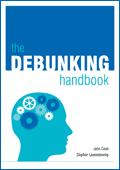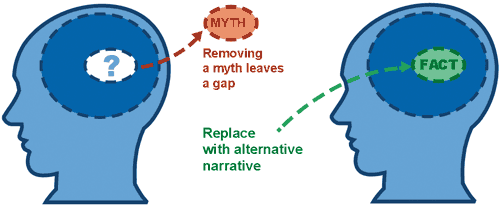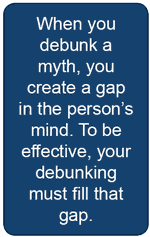The Debunking Handbook Part 5: Filling the gap with an alternative explanation
 The Debunking Handbook is an upcoming a now available guide to debunking myths, by John Cook and Stephan Lewandowsky. Although there is a great deal of psychological research on misinformation, unfortunately there is no summary of the literature that offers practical guidelines on the most effective ways of reducing the influence of misinformation. This Handbook boils down the research into a short, simple summary, intended as a guide for communicators in all areas (not just climate) who encounter misinformation. The Handbook will be available as a free, downloadable PDF at the end of this 6-part blog series.
The Debunking Handbook is an upcoming a now available guide to debunking myths, by John Cook and Stephan Lewandowsky. Although there is a great deal of psychological research on misinformation, unfortunately there is no summary of the literature that offers practical guidelines on the most effective ways of reducing the influence of misinformation. This Handbook boils down the research into a short, simple summary, intended as a guide for communicators in all areas (not just climate) who encounter misinformation. The Handbook will be available as a free, downloadable PDF at the end of this 6-part blog series.
This post has been cross-posted at Shaping Tomorrow's World.
Assuming you successfully negotiate the various backfire effects, what is the most effective way to debunk a myth? The challenge is that once misinformation gets into a person’s mind, it’s very difficult to remove. This is the case even when people remember and accept a correction.
This was demonstrated in an experiment in which people read a fictitious account of a warehouse fire.1,2,3 Mention was made of paint and gas cans along with explosions. Later in the story, it was clarified that paint and cans were not present at the fire. Even when people remembered and accepted this correction, they still cited the paint or cans when asked questions about the fire. When asked, “Why do you think there was so much smoke?”, people routinely invoked the oil paint despite having just acknowledged it as not being present.
When people hear misinformation, they build a mental model, with the myth providing an explanation. When the myth is debunked, a gap is left in their mental model. To deal with this dilemma, people prefer an incorrect model over an incomplete model. In the absence of a better explanation, they opt for the wrong explanation.4
In the warehouse fire experiment, when an alternative explanation involving lighter fluid and accelerant was provided, people were less likely to cite the paint and gas cans when queried about the fire. The most effective way to reduce the effect of misinformation is to provide an alternative explanation for the events covered by the misinformation.

This strategy is illustrated particularly clearly in fictional murder trials. Accusing an alternative suspect greatly reduced the number of guilty verdicts from participants who acted as jurors, compared to defences that merely explained why the defendant wasn’t guilty.5
For the alternative to be accepted, it must be plausible and explain all observed features of the event.6,1 When you debunk a myth, you create a gap in the person’s mind. To be effective, your debunking must fill that gap.
 One gap that may require filling is explaining why the myth is wrong. This can be achieved by exposing the rhetorical techniques used to misinform. A handy reference of techniques common to many movements that deny a scientific consensus is found in Denialism: what is it and how should scientists respond?7 The techniques include cherry picking, conspiracy theories and fake experts.
One gap that may require filling is explaining why the myth is wrong. This can be achieved by exposing the rhetorical techniques used to misinform. A handy reference of techniques common to many movements that deny a scientific consensus is found in Denialism: what is it and how should scientists respond?7 The techniques include cherry picking, conspiracy theories and fake experts.
Another alternative narrative might be to explain why the misinformer promoted the myth. Arousing suspicion of the source of misinformation has been shown to further reduce the influence of misinformation.8,9
Another key element to effective rebuttal is using an explicit warning (“watch out, you might be misled”) before mentioning the myth. Experimentation with different rebuttal structures found the most effective combination included an alternative explanation and an explicit warning.4
Graphics are also an important part of the debunker’s toolbox and are significantly more effective than text in reducing misconceptions. When people read a refutation that conflicts with their beliefs, they seize on ambiguities to construct an alternative interpretation. Graphics provide more clarity and less opportunity for misinterpretation. When self-identified Republicans were surveyed about their global warming beliefs, a significantly greater number accepted global warming when shown a graph of temperature trends compared to those who were given a written description.10
Another survey found that when shown data points representing surface temperature, people correctly judged a warming trend irrespective of their views towards global warming.11 If your content can be expressed visually, always opt for a graphic in your debunking.
References
- Seifert, C. M. (2002). The continued influence of misinformation in memory: What makes a correction effective? The Psychology of Learning and Motivation, 41, 265-292.
- Wilkes, A. L.; Leatherbarrow, M. (1988). Editing episodic memory following the identification of error, The Quarterly Journal of Experimental Psychology A: Human Experimental Psychology, 40A, 361-387.
- Johnson, H. M., & Seifert, C. M. (1994). Sources of the continued influence effect: When discredited information in memory affects later inferences. Journal of Experimental Psychology: Learning, Memory, and Cognition, 20 (6), 1420-1436.
- Ecker, U. K., Lewandowsky, S., & Tang, D. T. (2011). Explicit warnings reduce but do not eliminate the continued influence of misinformation. Memory & Cognition, 38, 1087-1100.
- Tenney, E. R., Cleary, H. M., & Spellman, B. A. (2009). Unpacking the doubt in “Beyond a reasonable doubt:” Plausible alternative stories increase not guilty verdicts. Basic and Applied Social Psychology, 31, 1-8.
- Rapp, D. N., & Kendeou, P. (2007). Revising what readers know: Updating text representations during narrative comprehension. Memory & Cognition, 35, 2019-2032.
- Diethelm, P., & McKee, M. (2009). Denialism: what is it and how should scientists respond? European Journal of Public Health, 19, 2-4.
- Lewandowsky, S., Stritzke, W. G., Oberauer, K., & Morales, M. (2005). Memory for fact, fiction and misinformation: The Iraq War 2003. Psychological Science, 16, 190-195.
- Lewandowsky, S., & Stritzke, W. G. K., Oberauer, K., & Morales, M. (2009). Misinformation and the ‘War on Terror’: When memory turns fiction into fact. In W. G. K. Stritzke, S. Lewandowsky, D. Denemark, J. Clare, & F. Morgan (Eds.), Terrorism and torture: An interdisciplinary perspective (pp. 179-203). Cambridge, UK: Cambridge University Press.
- Nyhan, B., & Reifler, J. (2011). Opening the Political Mind? The effects of self-affirmation and graphical information on factual misperceptions. In press.
- Lewandowsky, S. (2011). Popular consensus: Climate change set to continue. Psychological Science, 22, 460-463.
Posted by John Cook on Friday, 25 November, 2011
 The Debunking Handbook is an upcoming a now available guide to debunking myths, by John Cook and Stephan Lewandowsky. Although there is a great deal of psychological research on misinformation, unfortunately there is no summary of the literature that offers practical guidelines on the most effective ways of reducing the influence of misinformation. This Handbook boils down the research into a short, simple summary, intended as a guide for communicators in all areas (not just climate) who encounter misinformation. The Handbook will be available as a free, downloadable PDF at the end of this 6-part blog series.
The Debunking Handbook is an upcoming a now available guide to debunking myths, by John Cook and Stephan Lewandowsky. Although there is a great deal of psychological research on misinformation, unfortunately there is no summary of the literature that offers practical guidelines on the most effective ways of reducing the influence of misinformation. This Handbook boils down the research into a short, simple summary, intended as a guide for communicators in all areas (not just climate) who encounter misinformation. The Handbook will be available as a free, downloadable PDF at the end of this 6-part blog series.
 One gap that may require filling is explaining why the myth is wrong. This can be achieved by exposing the rhetorical techniques used to misinform. A handy reference of techniques common to many movements that deny a scientific consensus is found in Denialism: what is it and how should scientists respond?7 The techniques include cherry picking, conspiracy theories and fake experts.
One gap that may require filling is explaining why the myth is wrong. This can be achieved by exposing the rhetorical techniques used to misinform. A handy reference of techniques common to many movements that deny a scientific consensus is found in Denialism: what is it and how should scientists respond?7 The techniques include cherry picking, conspiracy theories and fake experts.
